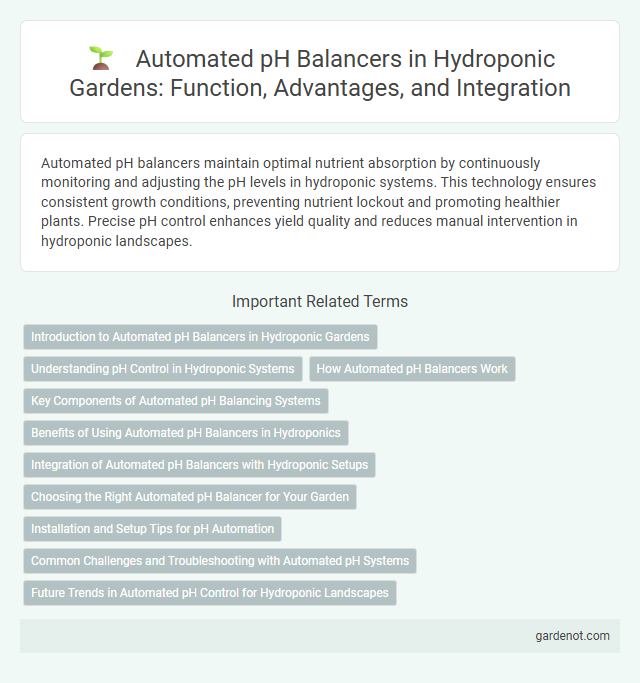Automated pH balancers maintain optimal nutrient absorption by continuously monitoring and adjusting the pH levels in hydroponic systems. This technology ensures consistent growth conditions, preventing nutrient lockout and promoting healthier plants. Precise pH control enhances yield quality and reduces manual intervention in hydroponic landscapes.
Introduction to Automated pH Balancers in Hydroponic Gardens
Automated pH balancers in hydroponic gardens continuously monitor and adjust the nutrient solution's pH levels to maintain optimal growing conditions. These devices use sensors and smart algorithms to detect pH fluctuations and deliver precise amounts of acid or base, ensuring nutrient availability and plant health. Consistent pH control enhances growth rates, reduces manual labor, and prevents nutrient lockout in hydroponic systems.
Understanding pH Control in Hydroponic Systems
Automated pH balancers maintain optimal nutrient absorption by continuously monitoring and adjusting the pH levels in hydroponic systems, typically targeting a range of 5.5 to 6.5 for most plants. Accurate pH control prevents nutrient lockout, ensuring plants receive essential minerals for growth and maximizing yield efficiency. Advanced sensors and dosing pumps work in real-time, enabling precise management of pH fluctuations caused by plant uptake and solution changes.
How Automated pH Balancers Work
Automated pH balancers in hydroponic landscapes use sensors to continuously monitor nutrient solution acidity, sending real-time data to control systems that activate acid or alkaline dosing pumps as needed. These devices maintain optimal pH levels (typically between 5.5 and 6.5) to enhance nutrient uptake efficiency and plant growth. By precisely adjusting pH without manual intervention, automated balancers reduce human error and promote consistent crop yields.
Key Components of Automated pH Balancing Systems
Automated pH balancer systems in hydroponic landscaping consist of key components such as pH sensors, dosing pumps, and control units that work together to maintain optimal nutrient solution pH levels. High-precision pH sensors continuously monitor the acidity or alkalinity of the water, while dosing pumps accurately deliver acid or base solutions to adjust pH in real-time. Advanced control units analyze sensor data and automate dosing, ensuring stable pH conditions that promote healthy plant growth and maximize crop yield.
Benefits of Using Automated pH Balancers in Hydroponics
Automated pH balancers in hydroponic systems ensure precise and consistent pH levels, optimizing nutrient availability and uptake for plants. These devices reduce manual monitoring, minimize human error, and maintain ideal growth conditions, leading to improved crop yields and healthier plants. Enhanced efficiency and real-time adjustments prevent pH fluctuations that can stress plants, making automated pH control essential for successful hydroponic cultivation.
Integration of Automated pH Balancers with Hydroponic Setups
Automated pH balancers seamlessly integrate with hydroponic setups by continuously monitoring and adjusting nutrient solution acidity levels to maintain optimal conditions for plant growth. These devices use sensors and dosing pumps connected to a central control system, enabling real-time pH corrections without manual intervention. Integration enhances precision, improves nutrient uptake efficiency, and reduces nutrient-related stress in hydroponic crops.
Choosing the Right Automated pH Balancer for Your Garden
Selecting the right automated pH balancer for your hydroponic garden requires evaluating factors such as reservoir size, sensor accuracy, and compatibility with your nutrient solution. Models featuring real-time pH monitoring and adjustable dosing pumps ensure precise nutrient availability and prevent pH fluctuations. Prioritizing devices with user-friendly interfaces and reliable calibration options enhances plant health and maximizes yield in hydroponic systems.
Installation and Setup Tips for pH Automation
Installing an automated pH balancer in hydroponic systems requires precise calibration of sensors to ensure accurate readings and optimal nutrient absorption. Position pH probes in a well-circulated area within the reservoir to prevent sediment interference and signal drift. Regularly check and maintain the calibration using standard buffer solutions to enhance system reliability and plant growth performance.
Common Challenges and Troubleshooting with Automated pH Systems
Automated pH balancers in hydroponic landscapes often face challenges such as sensor calibration drift, clogging of dosing pumps, and inconsistent pH readings caused by nutrient imbalances or biofilm buildup. Troubleshooting involves regular sensor calibration with standard buffer solutions, routine cleaning of dosing equipment, and monitoring nutrient solution composition to ensure stable pH levels. Implementing predictive maintenance schedules and using high-quality sensors can significantly reduce downtime and enhance system accuracy.
Future Trends in Automated pH Control for Hydroponic Landscapes
Future trends in automated pH control for hydroponic landscapes emphasize the integration of AI-driven sensors and real-time data analytics to enhance precision and stability in nutrient delivery. Emerging technologies prioritize adaptive systems that self-calibrate based on environmental variables, minimizing manual intervention and optimizing plant health. Innovations also include IoT connectivity for remote monitoring and predictive maintenance, ensuring consistent pH balance and maximizing crop yield efficiency.
Automated pH balancer Infographic

 gardenot.com
gardenot.com